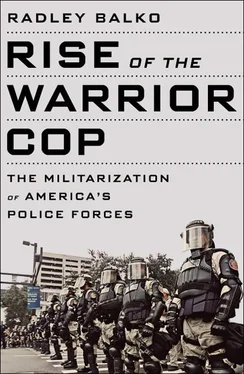10. Bovard, “Flash. Bang. You’re Dead,” p. 201.
11. The Donald Carlson narrative is taken from Carlson’s prepared testimony before the House Legislation and National Security Committee hearing, “Review of Federal Asset Forfeiture Program,” June 22, 1993; Bill Moushey, “The Damage of Lies,” Pittsburgh Post-Gazette, November 29, 1998; Phillip J. LaVelle, “Excesses Blamed in ‘Bad’ Raids,” San Diego Union-Tribune, December 13, 1992; and Valerie Alvord, “Drug Agents Say Informants Are an Essential Weapon in the War on Drugs,” San Diego Union-Tribune, May 29, 1995.
12. Myron Orfield Jr., “The Exclusionary Rule in Chicago,” Search and Seizure Law Report 19 (December 1992): 9.
13. Russell Jones, interview with the author, August 2012.
14. Richard Van Duizend et al., “The Search Warrant Process: Preconceptions, Perceptions, Practices” (Williamsburg, VA: National Center for State Courts, 1985), quoted in David E. Steinberg, “Zealous Officers and Neutral Magistrates: The Rhetoric of the Fourth Amendment,” Creighton Law Review 43 (June 2010): 1019.
15. David Migoya, “Judges Rubber-Stamp No-Knocks; Easy Approval Among Flaws in Process, Records Show,” Denver Post, February 27, 2000.
16. “Report of the Independent Commission on the Los Angeles Police Department,” Warren Christopher, chairman (1991), available at: http://www.parc.info/client_files/Special%20Reports/1%20-%20Chistopher%20Commision.pdf(accessed October 10, 2012).
17. The Gallup Organization, Inc., reprinted at Sourcebook of Criminal Justice Statistics Online, “Respondents’ Perceptions of Police Brutality in Their Area” (table), available at: http://www.albany.edu/sourcebook/pdf/t200012005.pdf(accessed October 10, 2012).
18. Norm Stamper, Breaking Rank: A Top Cop’s Exposé of the Dark Side of American Policing (New York: Nation Books, 2005), p. 162 (emphasis in original).
19. The narrative of Norm Stamper’s demilitarization proposal in San Diego is from the author’s phone interviews with Stamper, September 2012, and from Stamper’s book, Breaking Rank, pp. 162–165.
20. Tom Gabor, “Rethinking SWAT—Police Special Weapons and Tactical Units,” FBI Law Enforcement Bulletin (April 1993).
21. Quoted in Steven Elbow, “Hooked on SWAT; Fueled with Drug Enforcement Money, Military-Style Police Teams Are Exploding in the Backwoods of Wisconsin,” Madison Capital Times, August 18, 2001.
22. Timothy Egan, “Soldiers of the Drug War Remain on Duty,” New York Times, March 1, 1999.
23. Christian Parenti, “SWAT Nation,” The Nation, May 31, 1999.
24. New Haven Department of Police Service, “Crime Trends: 1990–2000: A Ten-Year Snapshot.” For a comparison with Connecticut crime rates, see US Department of Justice, Bureau of Justice Statistics, “Reported Crime in Connecticut.”
25. Kit Miniclier, “Critics Say ‘No-Knocks’ Dangerous, Unnecessary,” Denver Post, January 27, 1995.
26. Egan, “Soldiers of the Drug War Remain on Duty.”
27. US Department of Justice, National Institute of Justice, “Department of Justice and Department of Defense Joint Technology Program: Second Anniversary Report” (February 1997).
28. Michelle Alexander, The New Jim Crow: Mass Incarceration in the Age of Colorblindness (New York: New Press, 2012), pp. 141–145.
29. The ABC World News Tonight episode, which aired March 28, 1996, is summarized in Peter Kraska and Victor Kappeler, “Militarizing American Police: The Rise and Normalization of Paramilitary Units,” Social Problems 44 (1, February 1997).
30. 18 USC § 3109.
31. Wilson v. Arkansas, 514 US 927 (1995).
32. Richards v. Wisconsin, 520 US 385 (1997).
33. United States v. Ramirez, 523 US 65 (1998).
34. G. Gordon Liddy, The G. Gordon Liddy Show (syndicated radio program), August 26, 1994.
35. Ibid.
36. The Ruby Ridge narrative is from Alan W. Bock, Ambush at Ruby Ridge (New York: Berkley, 1996); and US Department of Justice, “Department of Justice Report Regarding Internal Investigation of Shootings at Ruby Ridge, Idaho During Arrest of Randy Weaver” (1996), redacted version available at: http://www.byington.org/carl/ruby/ruby1.htm(accessed October 30, 2012).
37. The Waco narrative is from Tim Lynch, “No Confidence: An Unofficial Account of the Waco Incident,” Cato Policy Analysis 395 (Washington, DC: Cato Institute, April 9, 2001); Bovard, “Flash. Bang. You’re Dead”; and David B. Kopel and Paul H. Blackman, No More Wacos: What’s Wrong with Federal Law Enforcement and How to Fix It (Amherst, NY: Prometheus Books, 1997).
38. In their book No More Wacos, Dave Kopel and Paul Blackman document numerous other incidents of botched raids, excessive force, and abuse of citizens at the hands of the ATF.
39. The Elián González narrative is from Ed Vulliamy, “Elián González and the Cuban Crisis: Fallout from a Big Row over a Little Boy,” The Guardian, February 20, 2010; “The Elian Gonzalez Case,” PBS Newshour Online, articles and commentary available at: http://www.pbs.org/newshour/bb/law/elian(accessed November 10, 2012).
40. Clarence Page, “Abuse by Immigration Agents Did Not Begin with Elian Case,” Chicago Tribune, May 16, 2000.
41. Quoted in Will Saletan, “The Elian Pictures,” Slate, April 25, 2000.
42. Ibid.
43. Unless otherwise noted, the Peter Kraska narrative and the SWAT figures are from Peter Kraska and Louis Cubellis, “Militarizing Mayberry and Beyond: Making Sense of American Paramilitary Policing,” Justice Quarterly 14 (4, December 1997); Peter Kraska and Victor Kappeler, “Militarizing American Police: The Rise and Normalization of Paramilitary Units,” Social Problems 44 (1, February 1997); Peter Kraska, “The Military-Criminal Justice Blur: An Introduction,” and “Playing War: Masculinity, Militarism, and Their Real-World Consequences,” both in Militarizing the American Justice System: The Changing Roles of the Armed Forces and the Police, ed. Peter Kraska (Evanston, IL: Northwestern University Press, 2001); Peter Kraska, “Questioning the Militarization of US Police: Critical Versus Advocacy Scholarship,” Policing and Society 9 (1999): 141–155; and author conversations with Kraska.
44. 4 Logan Herald-Journal, April 23, 2006.
45. Peter B. Kraska and V. E. Kappeler, “Militarizing American Police: The Rise and Normalization of Paramilitary Units,” Social Problems 13 (1997): 1–18.
46. Kraska and Cubellis, “Militarizing Mayberry and Beyond,” pp. 661–662.
47. Kraska, Militarizing the American Justice System, p. 12.
48. Megan Twohey, “SWATs Under Fire,” National Journal, January 1, 2000.
49. Neill Franklin, interview with the author, August 2012.
50. Stephen Downing, interview with the author, September 2012.
51. Ed Sanow, “Does SWAT Need to Be Explained?” Tactical Edge (September 2011).
52. Twohey, “SWATs Under Fire.”
53. Peter Kraska, “Playing War: Masculinity, Militarism, and Their Real-World Consequences,” in Militarizing the American Justice System: The Changing Roles of the Armed Forces and the Police, ed. Peter Kraska (Evanston, IL: Northwestern University Press, 2001).
54. Author interviews with Franklin, Downing, and Haase, all conducted in August 2012.
55. Federal News Service, White House briefing news conference, December 30, 1996.
56. Peter McWilliams, “The DEA Wishes Me a Nice Day” (self-published), available at: http://uts.cc.utexas.edu/~wbova/fn/earth/2000_6_03.htm.
Читать дальше












